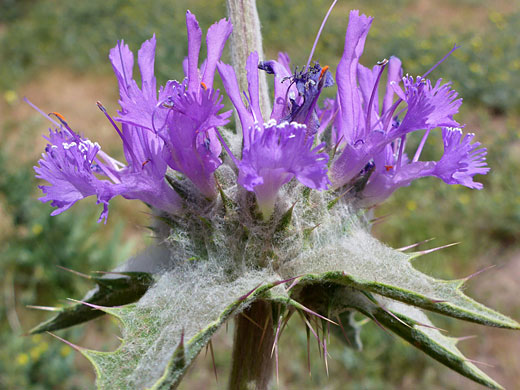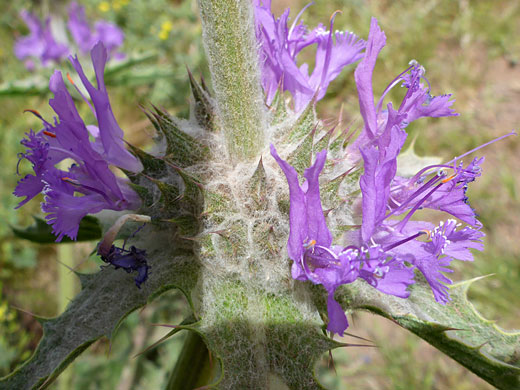Common name:
Thistle sage
Family:
Scientific name:
Salvia carduacea
Main flower color:
Range:
South and central California
Height:
Between 4 and 40 inches
Habitat:
Gravelly or sandy locations in sagebrush, chaparral and coastal regions, from near sea level to 4,500 feet
Leaves:
Sessile, oblanceolate, pinnately lobed; usually up to 4 inches long
Season:
March to June
Bracts and leaves of salvia carduacea are prickly, partly lobed and hairy, hence the common name of thistle sage. Plants are found across the foothills and valleys of southern California, extending south into Baja California, and they vary in height from a few inches to several feet, depending on water and nutrient levels. Stems and foliage are covered by white, woolly hairs, most densely around the bracts subtending the flowers. True leaves are restricted to the base, and are also variable in length; usually up to 4 inches but sometimes up to three times this. Leaf margins are wavy, and bear sharp spines at quite widely-spaced intervals.
A single stem has up to four whorled clusters of flowers, at the tip and the upper nodes, subtended by spiny, spreading, lance-shaped bracts up to 2 inches long. The flowers have a spiny, lobed calyx and a large, lavender to purple (occasionally white) corolla, which opens widely to a two-lobed upper lip and a three-lobed lower lip. All lobes are fringed, some quite deeply. The corolla tube can be up to one inch in length. The stamens are exserted; they have purple filaments and red-orange anthers.
A single stem has up to four whorled clusters of flowers, at the tip and the upper nodes, subtended by spiny, spreading, lance-shaped bracts up to 2 inches long. The flowers have a spiny, lobed calyx and a large, lavender to purple (occasionally white) corolla, which opens widely to a two-lobed upper lip and a three-lobed lower lip. All lobes are fringed, some quite deeply. The corolla tube can be up to one inch in length. The stamens are exserted; they have purple filaments and red-orange anthers.
All Contents © Copyright The American Southwest | Comments and Questions | Contribute | Site Map





